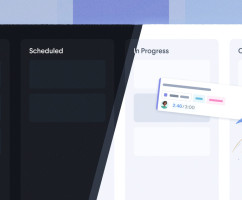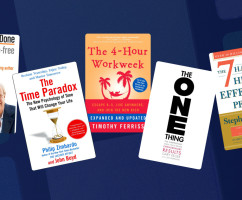This article is part of a series of articles on time management strategies. As with any strategy, the best one is the one that works for you! We encourage you to learn more about different time management strategies so that you can save time before implementing something that might not work out.
What Is Time Blocking?
Time blocking is a time management strategy that involves breaking your day into blocks of time. Each “block” is a separate task or project. How much time that block takes up in your schedule is really up to you.
Time blocking looks something like this:
While there are many advocates of time blocking—Cal Newport being the most recent and vocal—there’s no one person credited with its invention. In fact, time blocking has supposedly been used for hundreds, if not thousands of years as a means by which to organize one’s day. Nowadays, you’ll hear people credit Benjamin Franklin (a productivity master) as one of its early adopters, though the truth of the matter is, there’s nothing particularly novel about this time management strategy.
The gist of time blocking is this:
- Make a list of all of the things you need to accomplish in a day or week.
- Prioritize the items on that list.
- Open up your daily or weekly planner.
- Schedule your tasks or projects out individually, giving each one a distinct start and end time.
And that’s it. You’ve successfully time blocked your schedule.
So, why a whole article dedicated to this topic? Well, if you want to implement this time management strategy successfully, there’s a whole lot more you can do, or think about before you get started.
The Pros and Cons of Time Blocking
Let’s be honest, the reason you’re reading this isn’t just to learn about time blocking. You want to know if time blocking is the right time management strategy for you. So, let’s talk about that.
Time Blocking Pros:
It's easy to learn: There is a very low barrier to entry as it’s a simple technique to master, especially if you read this guide!
It will help you focus: If you need to do a lot of deep, focused work, this is a great strategy as it helps to prevent multitasking, which has been proved to interfere with productivity. In fact, we would go so far as to say that this is one of the real values of this time management strategy. When you slip into that deep work mode, you’ll also be more likely to produce better results, and who doesn’t want that?
You can start right away: All you need to do to implement this strategy is settle on a calendar tool, or a paper planner. Anything that will let you dedicate specific blocks of time to specific tasks, and that will also give you a birds-eye-view of your entire schedule at once.
It is flexible: Time blocking is suited to both very small tasks, and very large tasks. So, if you’re the kind of person who likes tracking things in 10 minute increments, you’ll be happy to know that you can use this strategy as easily as someone who likes to break their day up into 3 or 4 distinct tasks each spanning a couple of hours.
Time Blocking Cons:
Easy to be blown off course: If your schedule is often disrupted, or reworked (say, you have a lot of impromptu meetings that crop up in the week), you may find it hard to stick with your carefully time blocked schedule. Of course, you could try time blocking a single day at a time, instead of a whole week at once, but this method, even then, may still prove ineffective.
Task switching without built-in buffer time may degrade work quality: You will need to build in “buffer time” between tasks so that you can make the switch from working on one thing to the next easier. Without this transition time, you’ll have “attention residue” and be unable to focus wholly on the current task at hand. So, get up, get a glass of water, walk around the office or house, and get back to work with a clearer head.
This strategy does not help you prioritize tasks: Time blocking as a time management strategy does not necessarily help you prioritize tasks. That’s actually something you’re going to need to do yourself. There are, of course, other techniques that can help you do that. You may want to check out the Important-Urgent Matrix, or use the Most Important Tasks method. Either way, there are lots of quick and easy ways to figure out how to prioritize your task list.
As you can see, time blocking is an easy time management strategy to implement. It does have a few drawbacks of course, but none of them are very big. You’ll still need to keep your own general task list (unless you’re a pro at getting it on the calendar right away), and you’ll still need your own method for prioritizing your task list.
The big thing to remember if you’re considering adopting this technique, is that you need to be super realistic about how much you can get done in a day. As a rule of thumb, always start with less. You also need to be specific about the tasks you schedule for yourself. If one of those blocked out items involves multiple tasks, you are unlikely to get a real picture of your schedule. That’s not to say you can’t “batch” your smaller tasks, but to start with, try to really spell it all out.
How to Build Time Blocking Into Your Life
Fortunately, there’s an easy way to incorporate time blocking into your life. It’s called the to-do list. The reason I suggest starting with a to-do list is that it is a very literal brain dump. Once you have all of the things you need to get done in writing, it’s a lot easier to schedule them in your calendar.
You can make your own to-do list by hand, using your favorite task management app, or even in HourStack by simply scheduling out new entries (you can add start and end times to them later).
I use a combination of all three. When I’m out and about, my to-do’s go in Trello. When I’m at my desk, they go in my bullet journal.
From there it’s as simple as allocating a slot of time to get those to-do’s on your weekly calendar. I do it the night before, and if I’m super organized, or really worried about a busy week ahead, I do it Sunday evening, and prepare for the whole week.
Product tip: You can change the default time for a new entry by clicking the Preferences button above your calendar. Then, enter a new time and save your preferences.
With regards to prioritizing those to-do’s, that is where a little trial and error can help you, or a prioritization strategy.
Because our marketing team is very lean at HourStack, we like to prioritize 3 - 5 big items each week. Those are the essentials. Naturally, many other small things crop up in the day-to-day. Those get added to the calendar too as they also occupy time.
Ever since I learned about “attention residue,” I am careful to schedule in buffer times on each of my action items. Recall, if you transfer immediately from one task that requires focus to another, you won’t wholly be able to focus on the next task. The previous one will still be occupying a small portion of your attention.
To account for attention residue, I go for a short walk around the house or garden, or make a cup of tea. I don't create a separate to-do for that buffer time I know I'll need—though you may want to—I just build it in to the task's allocated time.
If you’re someone who likes to “do it right” from the start, I hate to tell you, but this is going to take some practice. While the time blocking methodology is easy to master, figuring out how much you can get done in a day is a very personal matter. It depends on how you work, what your job requires of you, whether or not you are frequently interrupted, how much sleep you’ve had, and so on.
Using HourStack as Your Time Blocking Planner
Personally, I’m a big proponent of time blocking, and it’s not just because I work at HourStack and get to see and hear first-hand how people use this technique to build efficient schedules.
Actually, even before I worked at HourStack, I had tried to adopt the notion of scheduling every to-do on my calendar. The problem with that tactic was that scheduling every tiny to-do on a traditional online calendar like Google or Outlook isn’t particularly fast. Online calendars are great for meetings and events, but not as good for my many small to-do’s and action items throughout the day.
What's impactful about using HourStack is that scheduling action items is ridiculously easy, and that the product integrates seamlessly with other tools. I still use my Google Calendar to schedule meetings, and I still use Trello to keep a running list of my to-do’s. The only difference is that I manage all of those action items in my HourStack calendar.
So, my day looks something like this:
As you can see, I’ve added labels, and in some cases, project names to my to-do’s. I also love that I can see where each of those to-do’s originates. Check out that tiny icon in the corner of some of my entries. In my case, it’s either from Trello, Google Calendar, or, if it doesn't have an icon, originated in HourStack.
Product Tip: Take advantage of the "day view" and get a pulse on how you are progressing. You'll notice that in the screenshot above my "scheduled" pie chart is showing some red. Looks like I'm set to work 9 hours, rather than 8. That means I've scheduled too much. Immediately I can tell I need to either remove a to-do, or fix an error. If you want to change the default number of hours you work in a day, even on a day-by-day basis, you can do that in the "Manage Tab."
While our team doesn’t use HourStack to track employee output, each of us uses it to manage our personal schedules. In fact, many of our customers who came across HourStack at work, actually adopted it for personal use.
Of course, if you don't want to use HourStack for time blocking, you can still use an online calendar tool, or a physical planner. The main advantage you get with HourStack, beyond ease of use and transparency for teams, is the reporting and data you get back. That data can help you understand what tasks are taking more time than they should be, where you're over-scheduling yourself, and much more.
If the thought of getting insight into how long it takes you to accomplish specific tasks excites you, and if time blocking sounds like a time management strategy that will help, I encourage you to give it a try. Don't forget to let us know how it works out.
How about giving HourStack a whirl in conjunction with time blocking? It's free for 14 days, no credit card required.
Updated September 21, 2022 in Tips & Tricks






